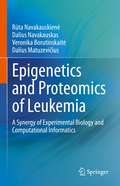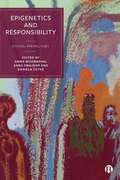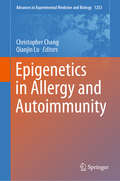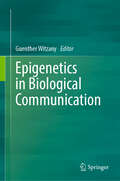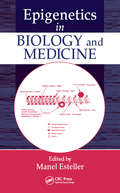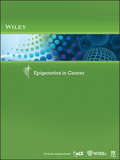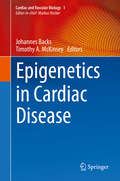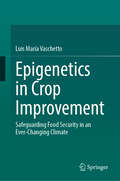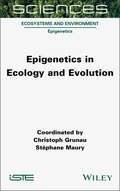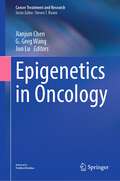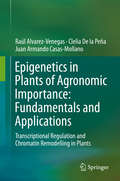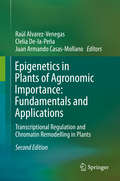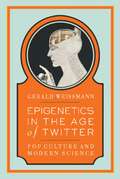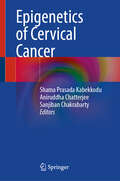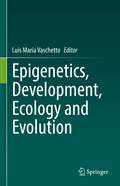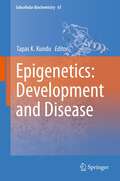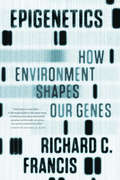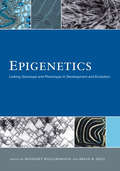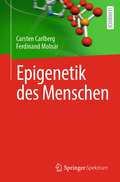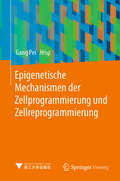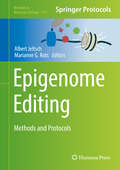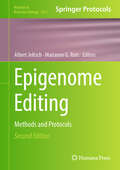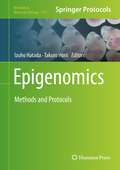- Table View
- List View
Epigenetics and Proteomics of Leukemia: A Synergy of Experimental Biology and Computational Informatics
by R¯uta Navakauskien˙e Dalius Navakauskas Veronika Borutinskait˙e Dalius Matuzevi˘ciusThis book reviews the current state of epigenetics and proteomics of leukemia and introduces the methods that are important to process and evaluate these factors in leukemia. In particular, epigenetic modifiers and their inhibitors in leukemia treatment as well as approaches to the epigenetic treatment of leukemia are covered. Various computational methods for proteome analysis are also described in detail, including 2DE fractionation and visualization, proteomic data processing, image acquisition and data anlaysis, and more. Protein localization in leukemia is also covered, in addition to the future of leukemia therapy. Epigenetics and Proteomics of Leukemia is an ideal book for advanced biomedical scientists and students, medical doctors and students, bioinformatics and health informatics researchers, computational biologists, structural biologists, systems biologists, and bioengineers.
Epigenetics and Responsibility: Ethical Perspectives
by Emma Moormann, Anna Smajdor and Daniela CutasEPUB and EPDF available Open Access under CC-BY-NC-ND licence. We tend to hold people responsible for their choices, but not for what they can’t control: their nature, genes or biological makeup. This thought-provoking collection redefines the boundaries of moral responsibility. It shows how epigenetics reveals connections between our genetic make-up and our environment. The essays challenge established notions of human nature and the nature/nurture divide and suggest a shift in focus from individual to collective responsibility. Uncovering the links between our genetic makeup, environment and experiences, this is an important contribution to ongoing debates on ethics, genetics and responsibility.
Epigenetics in Allergy and Autoimmunity (Advances in Experimental Medicine and Biology #1253)
by Christopher Chang Qianjin LuThis book will address the growing roles of epigenetics in disease pathogenesis, and review the contribution of epigenetic modifications to disease onset and progression. The roles that epigenetics plays in facilitating effects of the environment on allergy and immunologic diseases will be reviewed. The book is divided into three parts – the first is an introduction to epigenetics and the methods that have been developed to study epigenetics, the second addresses epigenetics in allergic diseases and the third part will cover epigenetics in autoimmune diseases. With the rapid expansion of knowledge of how genes are regulated and how this regulation affects disease phenotypes, this book will be attractive to experienced researchers as well as those just launching an epigenetics research program. It will also be of interest to allergist, immunologists, rheumatologists and dermatologist who are engaged in clinical practice as a resource for understanding the basis for personalized and precision medicine. For example, the role that epigenetics plays in the pathogenesis in various allergic and autoimmune disorders and how this determines disease phenotypes will be covered extensively in this book. This book will thus help fill the gap in available resources on epigenetics in allergy and autoimmune diseases.
Epigenetics in Biological Communication
by Guenther WitzanyEvery cell, tissue, organ and organism is competent to use signs to exchange information reaching common coordinations and organisations of both single cell and group behavior. These sign-mediated interactions we term biological communication. The regulatory system that works in development, morphology, cell fate and identity, physiology, genetic instructions, immunity, memory/learning, physical and mental disease depends on epigenetic marks. The communication of cells, persistent viruses and their defectives such as mobile genetic elements and RNA networks ensures both the transport of regulatory instructions and the reprogramming of these instructions. But how are the different states of the epigenome orchestrated? The epigenetic pathways respond to various signaling cues such as DNA methylation, histone variants, histone modifications, chromatin structure, nucleosome remodeling, and epigenetic interactions. Epigenetic signals are responsible for the establishment, maintenance and reversal of transcriptional states that are fundamental for the cell's ability to memorize past events, such as changes in the external environment, socio-sphere or developmental cues. External signals trigger changes in the epigenome, allowing cells to respond dynamically. Internal signals direct activities that are necessary for body maintenance, and repairing damaged tissues and organs. With the emergence of epigenetic memory, organisms can fix historical and context dependent impressive experiences. Evolution from now on learnt to learn. Learning means organisms can avoid reproduction of always the same. This is key to adaptation. However, inheritance of acquired characteristics is only one of the many examples of the explanatory power of epigenetics. Behavioral epigenetics demonstrates the way in which environmental and social experiences produce individual differences in behaviour, cognition, personality, and mental health. This book assembles experts to outline the various motifs of all kinds of epigenetic regulation of cells throughout their lives.
Epigenetics in Biology and Medicine
by Manel EstellerAnomalous epigenetic patterns touch many areas of study including biomedical, scientific, and industrial. With perspectives from international experts, this resource offers an all-inclusive overview of epigenetics, which bridge DNA information and function by regulating gene expression without modifying the DNA sequence itself. Epigenetics, in its
Epigenetics in Cancer (Life Science Research Fundamentals)
by WileyEpigenetics is the study of heritable changes in gene expression or cellular phenotype, caused by mechanisms other than changes in the DNA sequence. Examples include DNA methylation and histone modification. These changes may remain through cell divisions and multiple generations. Epigenetic differences among individuals may account for some of the differences between monozygotic (identical) twins. Aberrant DNA methylation is also frequently associated with human aging and diseases, such as cancer. This collection of overviews and laboratory protocols provides crucial, distilled information about the roles of epigenetics in cancer development. The overviews are geared for research scientists who need to learn more about the current understanding of epigenetic variation in humans and how the processes of DNA methylation and histone modification are regulated. The protocols give step-by-step instructions on how to detect DNA methylation using various methods such as MAPit, CHARM (arrays) and methylation-specific PCR. This e-book — a curated collection from eLS, WIREs, and Current Protocols — offers a fantastic introduction to the fields of genetics, genomics, and oncogenesis for students or interdisciplinary collaborators.
Epigenetics in Cardiac Disease (Cardiac and Vascular Biology #1)
by Johannes Backs Timothy A. McKinseyThis book describes important advances in our understanding of how environmental conditions affect cardiac gene expression through epigenetic mechanisms. Further, it discusses the roles of chromatin modifications (in particular DNA methylation and histone modifications) and of chromatin regulators in the context of cardiac diseases. The book provides readers with an overview of our current understanding of epigenetic regulation in the heart, and will stimulate further research in this exciting field. Edited and written by internationally respected experts, it addresses the needs of professors, students and researchers working in the fields of cardiac biology and epigenetics.
Epigenetics in Crop Improvement: Safeguarding Food Security in an Ever-Changing Climate
by Luis María VaschettoEpigenetics encompasses all changes in gene expression that occur without alterations to the DNA sequence. These modifications involve DNA methylation, histone modifications, and ncRNA pathways. Plants have evolved remarkable resilience to environmental challenges mediated by epigenetic modifications rather than genetic variation. Epigenetic variation provides a means for designing crop varieties with enhanced resilience to abiotic stresses, such as drought, salinity, and extreme temperatures. By understanding how epigenetic information systems interact among them and with other canonical genetic pathways, we can develop crops better equipped to withstand the challenges of climate change, ultimately contributing to global food security. Epigenetics in Crop Improvement: Safeguarding Food Security in an Ever-Changing Climate is primarily a comprehensive guide that explores the role of epigenetics in plant growth, development, and adaptation. This book also offers a valuable resource for anyone looking to investigate and develop innovative strategies for enhancing crop resilience and productivity in the face of climate change.
Epigenetics in Ecology and Evolution (ISTE Invoiced)
by Christoph Grunau Stéphane MauryGenetics and its mysterious little sister, epigenetics, have deep roots in the history of biology. Today, epigenetics is of paramount importance in not only the fundamental sciences, but also in life science applications, ranging from molecular biology, and disease diagnosis and treatment, to agriculture. Epigenetics in Ecology and Evolution traces the history of the concept of epigenetics in biology and describes the molecular mechanisms concerned. It examines the contributions that the emerging discipline of epigenetics has made to the fields of ecology and evolution, regarding both plant and animal organisms, as well as its place in our society. By exploring the importance of epigenetics at varying levels, from the cell to the organism as a whole, and even to the ecosystem, this book offers answers that are accessible to a wide audience, from scientifically curious citizens to students and professionals working in the world of biology. The aim is to enable everyone to acquire or develop a critical and informed perspective on the complex relationships between genetics and epigenetics.
Epigenetics in Oncology (Cancer Treatment and Research #190)
by Jun Lu Jianjun Chen G. Greg WangThis book addresses Epigenetics in Cancer and covers the most recent advances in RNA/histone/DNA epigenetics in Oncology. RNA/histone/DNA epigenetics have been shown to play pivotal roles in cancer initiation, progression, maintenance and drug response/resistance, tumor microenvironment, cancer stem cell self-renewal, cancer metabolism, and tumor immune evasion. In particular, research in RNA cancer epigenetics has made impressive progress in the last few years.Individual chapters in Part I (focusing on RNA epigenetics) are devoted to RNA modifications in Cancer Metabolism and Microenvironment, Cancer Stem Cell Biology, Immune Surveillance, Solid Tumors and Tumor Immunity, and Hematopoietic Malignancies, as well as to RNA editing in Cancer. Chapters in Part II and III of the book focus on histone epigenetics and DNA epigenetics, respectively.By familiarizing readers with the latest developments in this complex and challenging field, the book offers a valuable resource for scientists, graduate students and clinicians alike.
Epigenetics in Plants of Agronomic Importance: Fundamentals and Applications
by Raúl Alvarez-Venegas Clelia De la Peña Juan Armando Casas-MollanoOver the past decades, chromatin remodelling has emerged as an important regulator of gene expression and plant defense. This book provides a detailed understanding of the epigenetic mechanisms involved in plants of agronomic importance. The information presented here is significant because it is expected to provide the knowledge needed to develop in the future treatments to manipulate and selectively activate/inhibit proteins and metabolic pathways to counter pathogens, to treat important diseases and to increase crop productivity. New approaches of this kind and the development of new technologies will certainly increase our knowledge of currently known post-translational modifications and facilitate the understanding of their roles in, for example, host-pathogen interactions and crop productivity. Furthermore, we provide important insight on how the plant epigenome changes in response to developmental or environmental stimuli, how chromatin modifications are established and maintained, to which degree they are used throughout the genome, and how chromatin modifications influence each another.
Epigenetics in Plants of Agronomic Importance: Transcriptional Regulation and Chromatin Remodelling in Plants
by Raúl Alvarez-Venegas Juan Armando Casas-Mollano Clelia De-la-PeñaOver the past few decades, chromatin modulation has emerged as an important regulator of gene expression. This second edition provides detailed information on the epigenetic mechanisms in plants, illustrating the value of this research in plants of agronomic importance. It examines recent advances regarding plants’ epigenetic regulation in response to abiotic and biotic types of stress; the epigenetic basis of plant immunity; evolution and functions of plant histones; epigenetic variation and plant breeding; and epigenome editing and crop improvement. The content is intended to promote the development of future biotechnologies to manipulate and selectively activate/inhibit proteins and metabolic pathways to counter pathogens, to treat important diseases, and to increase crop productivity. The development of new fields, like epigenome editing and RNA epigenetics, will certainly improve our understanding of currently known epigenetic modifications and their roles in e.g. host-pathogen interactions, crop productivity, and in response to environmental stimuli. This volume contains twelve new/revised chapters, written by an international team of experts on plant epigenetics, and addresses the needs of researchers and professionals in the fields of agronomics, crop breeding, epigenetics, plant biochemistry, plant developmental biology, and related disciplines.
Epigenetics in the Age of Twitter
by Gerald WeissmannPop culture meets cutting-edge science in this one-volume introduction to the history of science and modern biology."[Weissmann] has emerged in the last three decades as America's most interesting and important essayist. He has achieved this status both epigenetically and through Twitter, word of mouth, so to speak. . . . Much like Susan Sontag, Weissmann likes being a contemporary, and does not feel shackled by tradition. . . . This book is a joy for the heart and instructive for the mind." -ERIC KANDEL, Nobel Laureate and author of In Search of Memory"Only a mind as nimble and well traveled as Gerald Weissmann's could see, never mind make and expound on, the connections between salamanders and Prohibition . . . white blood cells, Hollywood and erectile dysfunction . . . health care reform and Marie Antoinette . . . bacteria, the Equal Rights Amendment and the "Miracle on the Hudson." Better yet, Weissmann does so with wit and insight. A fascinating tour through history, science and pop culture." -MAX GOMEZ, MD, Emmy Award-winning WCBS-TV Medical Correspondent"Erudite energy leaps from this lively commingling of art, culture and science. . . . In each [essay], Weissmann finds links between research and elements of history and pop culture, which play off each other to illuminating effect. So US politician Sarah Palin pops up in a discussion of 'Marie Antoinette syndrome'. . . and the 'meltdown' of the mythical Icarus meets the nuclear version at the Fukushima Daiichi power plant in Japan." -NatureEpigenetics, which attempts to explain how our genes respond to our environment, is the latest twist on the historic nature vs. nurture debate. In addressing this and other controversies in contemporary science, Gerald Weissmann taps what he calls "the social network of Western Civilization," including the many neglected women of science: from the martyred Hypatia of Alexandria, the first woman scientist, to the Nobel laureates Marie Curie, Christiane Nüsslein-Volhard, and Elizabeth Blackburn, among other luminaries in the field. Always instructive and often hilarious, this is a one-volume introduction to modern biology, viewed through the lens of today's mass media and the longer historical tradition of the Scientific Revolution. Whether engaging in the healthcare debate or imagining the future prose styling of the scientific research paper in the age of Twitter, Weissmann proves to be one of our most incisive cultural critics and satirists.Gerald Weissmann is director of the Biotechnology Study Center at the New York University School of Medicine and editor-in-chief of the FASEB Journal. His essays and reviews have appeared in numerous publications worldwide, including the London Review of Books and New York Times Book Review.
Epigenetics of Cervical Cancer
by Shama Prasada Kabekkodu Aniruddha Chatterjee Sanjiban ChakrabartyThis book focuses on the fundamentals of epigenetics, covering the roles of DNA methylation, histone modifications, and non-coding RNA, especially miRNA and lncRNA, in cervical cancer. The chapters discuss various methods to detect epigenetic changes and how these changes could be useful for diagnosis, prognosis, as well as epigenetic therapy. Further chapters address the up-to-date approaches and solutions to the parameterizing bottlenecks associated with the translation of these findings for the management of cervical cancer. The book is supplemented with figures and tables to aid conceptual understanding. The book is relevant for researchers, academicians, scientists, as well as medical students seeking to understand the fundamentals of cervical cancer based on environmental or genetic factors.
Epigenetics, Development, Ecology and Evolution
by Luis María VaschettoEpigenetic modifications comprise heritable gene expression changes that occur without alteration of the DNA sequence and 'co-act' with genetic factors to shape development processes and evolutionary trajectories. Multicellular organisms receive different types of environmental stimuli/stresses that trigger epigenetic modifications during development. These environmentally driven mechanisms represent an underlying cause of phenotypic diversity, especially in metazoans. This book aims to present some of the latest epigenetic insights into the development of metazoans (including humans) as an intersection between their ecology and evolution.
Epigenetics: Development and Disease
by Tapas Kumar KunduEpigenetics fine-tunes the life processes dictated by DNA sequences, but also kick-starts pathophysiological processes including diabetes, AIDS and cancer. This volume tracks the latest research on epigenetics, including work on new-generation therapeutics.
Epigenetics: How Environment Shapes Our Genes
by Richard C. FrancisGoodbye, genetic blueprint. . . . The first book for general readers ?on the game-changing field of epigenetics. The burgeoning new science of epigenetics offers a cornucopia of insights--some comforting, some frightening. For example, the male fetus may be especially vulnerable to certain common chemicals in our environment, in ways that damage not only his own sperm but also the sperm of his sons. And it's epigenetics that causes identical twins to vary widely in their susceptibility to dementia and cancer. But here's the good news: unlike mutations, epigenetic effects are reversible. Indeed, epigenetic engineering is the future of medicine.
Epigenetics: Linking Genotype and Phenotype in Development and Evolution
by Benedikt Hallgrímsson Brian K. HallIlluminating the processes and patterns that link genotype to phenotype, epigenetics seeks to explain features, characters, and developmental mechanisms that can only be understood in terms of interactions that arise above the level of the gene. With chapters written by leading authorities, this volume offers a broad integrative survey of epigenetics. Approaching this complex subject from a variety of perspectives, it presents a broad, historically grounded view that demonstrates the utility of this approach for understanding complex biological systems in development, disease, and evolution. Chapters cover such topics as morphogenesis and organ formation, conceptual foundations, and cell differentiation, and together demonstrate that the integration of epigenetics into mainstream developmental biology is essential for answering fundamental questions about how phenotypic traits are produced.
Epigenetics: The Ultimate Mystery of Inheritance
by Richard C. FrancisA writer with a PhD in neurobiology explains why "identical" twins can have different risks for health problems, how the effects of famine can be inherited across generations, and the dynamics of the breeding of hybrid animals. Francis presents an interesting, accessible introduction to epigenetics, a new field that studies how the environment (prenatal, social, and chemical stressors) can have long-term physiological and behavioral effects through regulating genes. He explains how this process offers promise for understanding development and obesity, and treating cancer. Annotation ©2011 Book News, Inc., Portland, OR (booknews.com)
Epigenetik des Menschen
by Carsten Carlberg Ferdinand MolnárDie Ansicht „Es liegt alles in unseren Genen und wir können es nicht ändern“ hat sich in den letzten 150 Jahren seit Gregor Mendels Experimenten mit blühenden Erbsenpflanzen entwickelt. Es gibt jedoch eine besondere Form der Genetik, die Epigenetik, bei der unsere Gene nicht verändert werden, sondern geregelt wird, wie und wann sie genutzt werden. Unsere Umwelt und Lebensstilentscheidungen beeinflussen die Epigenetik unserer Zellen und Organe, d. h. die Epigenetik verändert sich dynamisch während unseres gesamten Lebens. Wir haben also die Möglichkeit, unsere Epigenetik sowohl positiv als auch negativ zu verändern.In diesem Buch wird auf molekularer Ebene erklärt, wie unser Genom mit Umweltsignalen verbunden ist. Es zeigt auf, dass die epigenetische Programmierung ein Lernprozess ist, der zu einem epigenetischen Gedächtnis in jeder Zelle unseres Körpers führt. Die zentrale Bedeutung der Epigenetik während der Embryogenese und der zellulären Differenzierung sowie beim Alterungsprozess und dem Risiko für die Entstehung von Krebs werden erörtert. Darüber hinaus wird die Rolle des Epigenoms als molekularer Speicher für zelluläre Ereignisse nicht nur im Gehirn, sondern auch in Stoffwechselorganen und im Immunsystem beschrieben.Das Buch ist die Übersetzung des Lehrbuchs „Human Epigenetics: How Science Works“ (ISBN 978-3-030-22907-8) der Autoren. In den ersten fünf Kapiteln werden die molekularen Grundlagen der Epigenetik erläutert, während die folgenden sieben Kapitel Beispiele für die Auswirkungen der Epigenetik auf die menschliche Gesundheit und Krankheit liefern.
Epigenetische Mechanismen der Zellprogrammierung und Zellreprogrammierung
by Gang PeiDieses Buch stellt ein umfangreiches Forschungsprogramm zu epigenetischen Mechanismen der Zellprogrammierung und Reprogrammierung vor. Das Programm wurde von der National Natural Science Foundation of China während des 11. Fünfjahresplans gestartet, der im Oktober 2008 begann und Ende 2016 abgeschlossen wurde. Es fasst zunächst die epigenetischen Forschungspläne und den aktuellen Stand der epigenetischen Forschung in China und im internationalen Vergleich zusammen. Unter Anwendung interdisziplinärer Forschungsmethoden erörtert das Buch die Entwicklungstrends der epigenetischen Forschung, wie die Mechanismen der Etablierung und Aufrechterhaltung epigenetischer Informationen und die epigenetische Regulierung von Reproduktion und Entwicklung. Außerdem wird eine Vielzahl von Forschungsergebnissen vorgestellt. So werden beispielsweise die Entdeckung neuer epigenetischer Regulatoren und Chromatin-Remodulatoren sowie deren biologische Funktionen und Mechanismen hervorgehoben. Es werden verschiedene Regulierungsmechanismen der Zelldifferenzierung und Transdifferenzierung erörtert, insbesondere die Entdeckung der Schlüsselfaktoren zur Förderung der Transdifferenzierung von Körperzellen zu Hepatozyten. Darüber hinaus werden in diesem Buch einige wichtige akademische Bereiche mit zunehmender Bedeutung vorgestellt, wie Biochemie, Zellbiologie und klinische Medizin. Aufgrund seines Umfangs ist das Buch für Forscher interessant, die in den Bereichen Zellbiologie, Biochemie, Strukturbiologie, Bioinformatik, klinische Medizin und anderen verwandten Gebieten arbeiten.
Epigenome Editing: Methods And Protocols (Methods In Molecular Biology #1767)
by Albert Jeltsch Marianne G. RotsThis detailed book explores the concepts and applications of epigenome editing, as presented by leading scientists in the field. Beginning with some general and topical reviews, the collection continues by covering the design of DNA-binding devices, optimization of the effector domains, readout of epigenome marks, and approaches for delivery at the cellular and organismal level. Written for the highly successful Methods in Molecular Biology series, chapters include introductions to their respective topics, lists of the necessary materials and reagents, step-by-step, readily reproducible laboratory protocols, and tips on troubleshooting and avoiding known pitfalls. Authoritative and practical, Epigenome Editing: Methods and Protocols will be of great assistance to people new to the field but also to those already engaged, as epigenetic editing is still a relatively unexplored field with many issues to be resolved.
Epigenome Editing: Methods and Protocols (Methods in Molecular Biology #2842)
by Albert Jeltsch Marianne G. RotsThis second volume details new and updated methods covering applications of epigenome editing. Chapters guide readers through general and topical reviews, DNA-binding devices, optimization of the effector domains, readout of epigenome marks, and approaches for delivery at the cellular and organismal level. Written in the highly successful Methods in Molecular Biology series format, chapters include introductions to their respective topics, lists of the necessary materials and reagents, step-by-step, readily reproducible laboratory protocols, and key tips on troubleshooting and avoiding known pitfalls. Authoritative and cutting-edge, Epigenome Editing: Methods and Protocols, Second Editon aims to ensure successful results in the further study of this vital field.
Epigenomics
by Krishnarao Appasani Azim SuraniUnderstanding mechanisms of gene regulation that are independent of the DNA sequence itself – epigenetics – has the potential to overthrow long-held views on central topics in biology, such as the biology of disease or the evolution of species. High throughput technologies reveal epigenetic mechanisms at a genome-wide level, giving rise to epigenomics as a new discipline with a distinct set of research questions and methods. Leading experts from academia, the biotechnology and pharmaceutical industries explain the role of epigenomics in a wide range of contexts, covering basic chromatin biology, imprinting at a genome-wide level, and epigenomics in disease biology and epidemiology. Details on assays and sequencing technology serve as an up-to-date overview of the available technological tool kit. A reliable guide for newcomers to the field as well as experienced scientists, this is a unique resource for anyone interested in applying the power of twenty-first-century genomics to epigenetic studies.
Epigenomics: Methods and Protocols (Methods in Molecular Biology #2577)
by Izuho Hatada Takuro HoriiThis detailed volume provides a comprehensive collection of protocols for epigenomic research, powering our ability to analyze epigenetic modifications across the entire genome. Beginning with methods used to investigate epigenomic modifications such as DNA methylation, histone modifications, and chromatin structure, the book continues with methods for manipulating the epigenome, including platforms for epigenome editing, inducible systems for epigenome editing, and epigenetically modified animals. Written for the highly successful Methods in Molecular Biology series, chapters feature introductions to their respective topics, lists of the necessary materials and reagents, step-by-step and readily reproducible laboratory protocols, and tips on troubleshooting and avoiding known pitfalls. Authoritative and practical, Epigenomics: Methods and Protocols serves as an ideal resource for researchers looking to further expand the utility and scope of epigenomics research.
